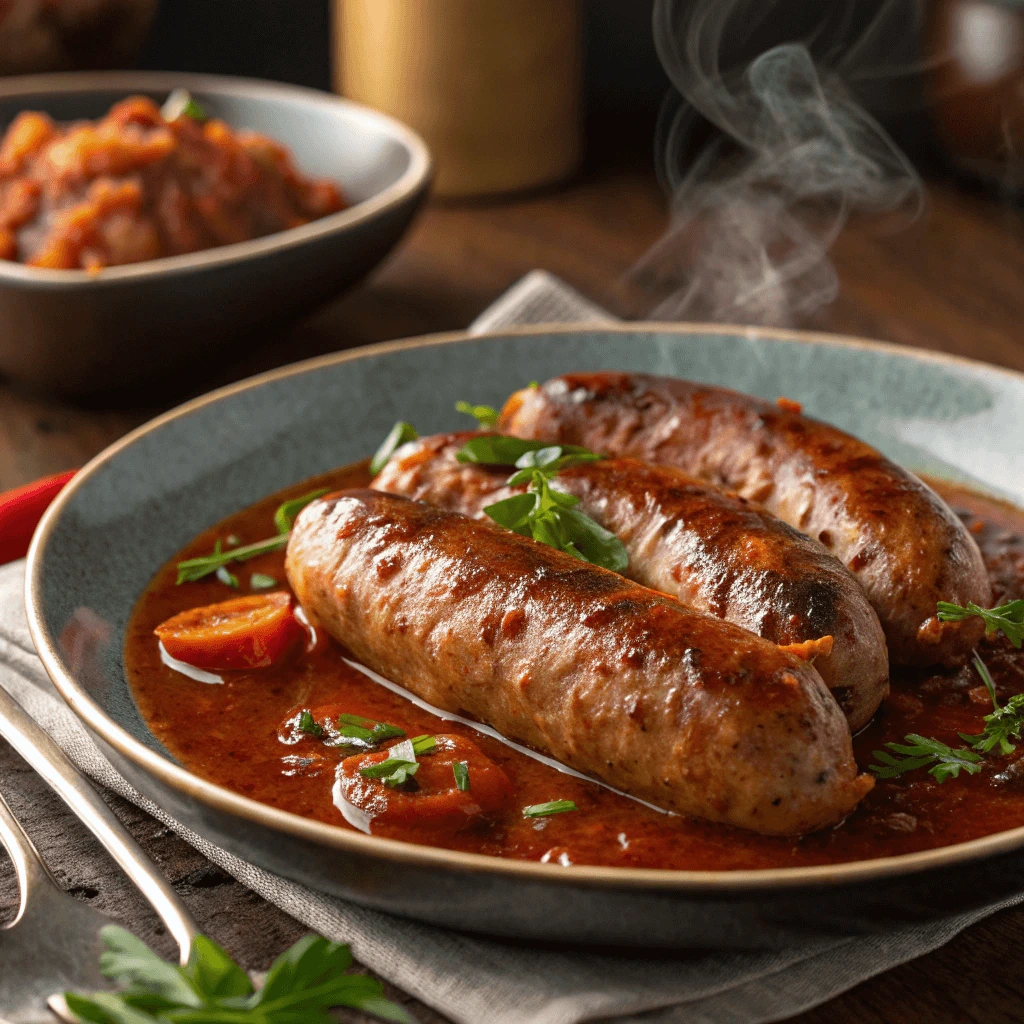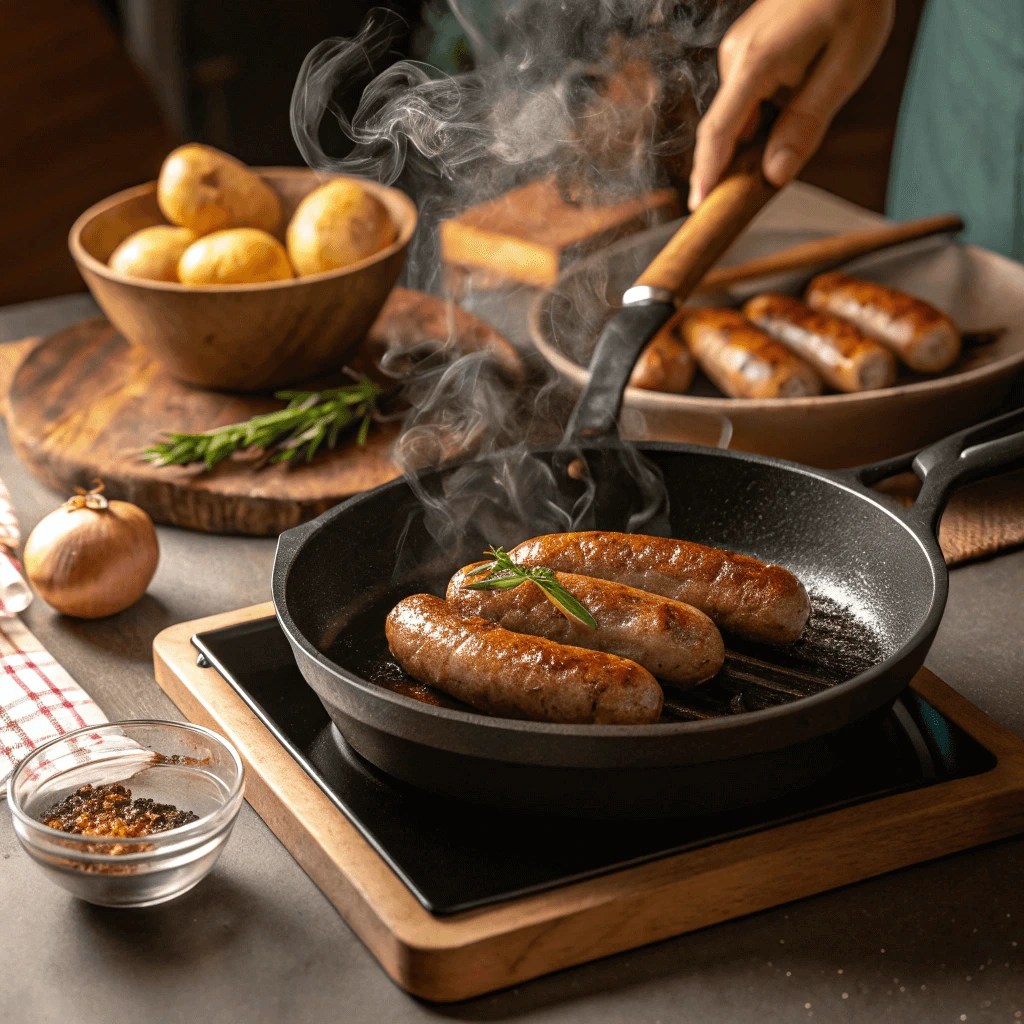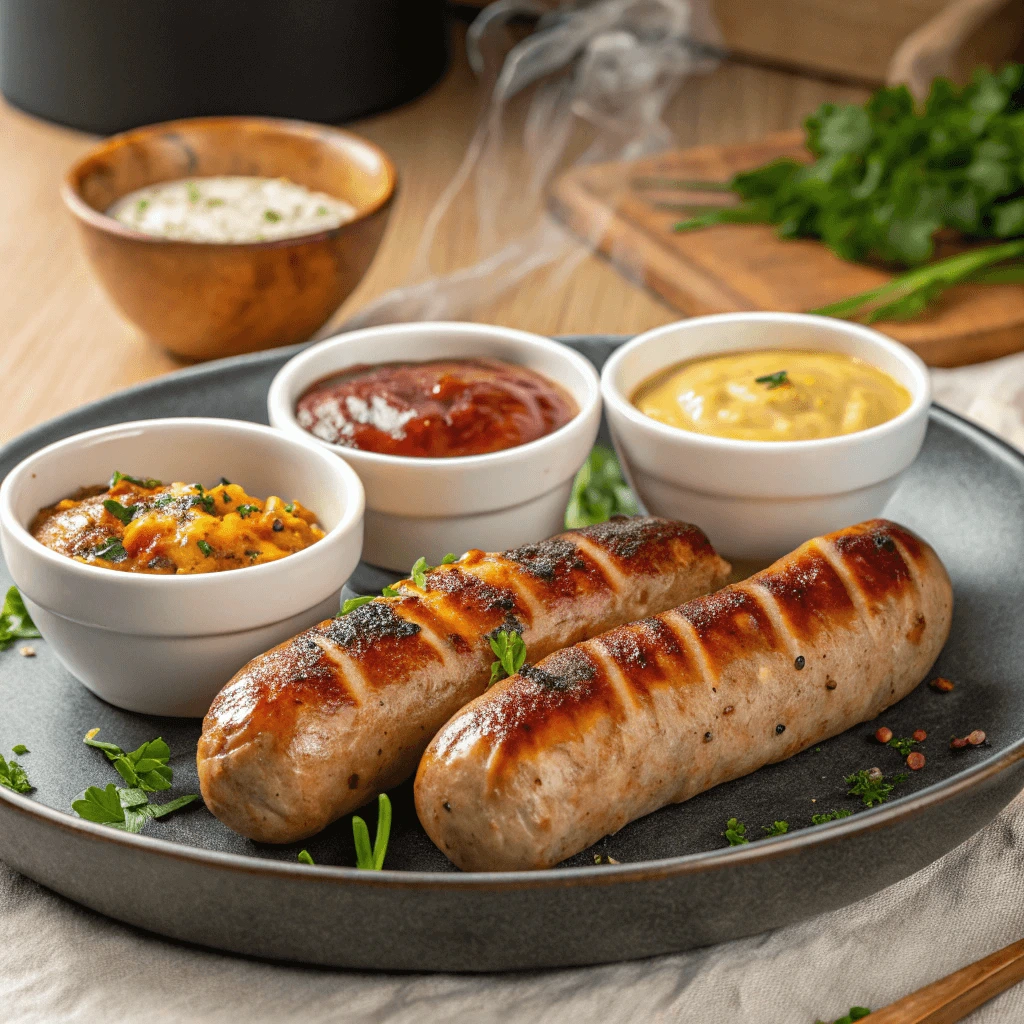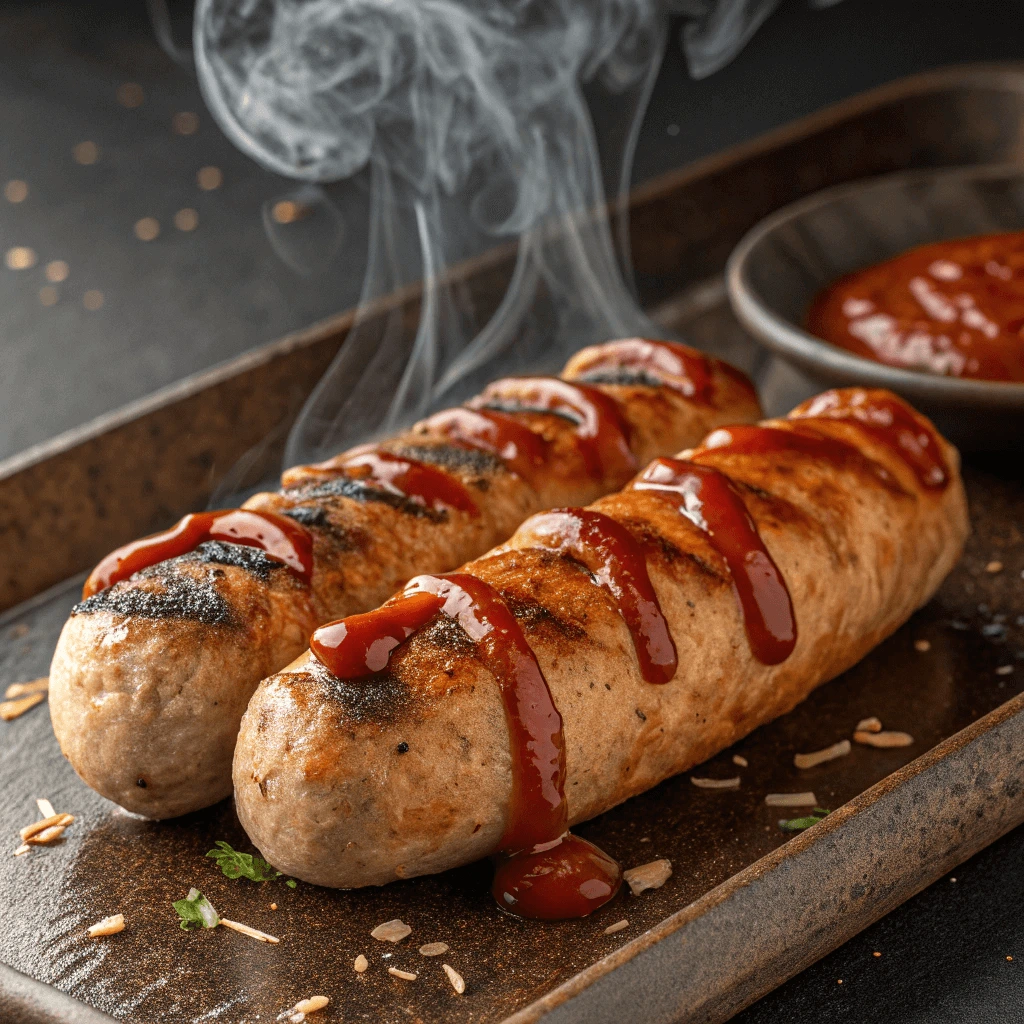Hot sausage adds bold, spicy flavor to any meal and offers versatile cooking options. Whether you choose chicken, turkey, beef, or plant-based varieties, mastering how to cook hot sausage perfectly can elevate your dishes. This ultimate guide covers everything from selecting the right sausage to cooking methods, pairing with delicious sides, and choosing sauces that complement the heat. Get ready to explore tasty, creative ways to enjoy hot sausage while keeping your meals flavorful.
Understanding Hot Sausage Varieties and Flavors

Types of Hot Sausage
Choosing the right hot sausage depends on your taste and dietary needs. Each type offers unique flavors and textures.
Chicken Hot Sausage
Chicken sausage is lean and mild but carries spices well. It cooks quickly and stays juicy. This option suits light meals and pairs nicely with bold seasonings.
Turkey Hot Sausage
Turkey sausage has a firm texture and fewer calories. It handles strong spices like cayenne or chipotle and works great in salads or grain bowls for a healthy boost.
Beef Hot Sausage
Beef sausage offers a richer, meaty flavor with a firmer bite. It contains more fat, which keeps it juicy. This sausage pairs well with hearty sides like roasted potatoes.
Plant-Based Hot Sausage
Plant-based sausages use ingredients like soy or pea protein. They replicate spicy flavors and textures, making them perfect for vegetarian or vegan meals.
Key Spices and Seasonings in Hot Sausage
Hot sausage gets its bold flavor from a mix of carefully chosen spices and seasonings. Understanding these ingredients helps you appreciate the unique taste each variety offers.
Chili Peppers and Heat Sources
Chili peppers like cayenne, paprika, and crushed red pepper flakes provide the signature heat in hot sausage. They vary in intensity, allowing sausage makers to control the spice level precisely. These peppers also add vibrant color to the sausage.
Garlic and Onion
Garlic and onion powder enhance the savory depth of hot sausage. They contribute to the aroma and balance the spice, creating a full-bodied flavor that complements many dishes.
Herbs and Spices
Common herbs like oregano, thyme, and fennel seed add complexity. Fennel seed, in particular, lends a slightly sweet, licorice-like note often found in Italian-style sausages. Other spices such as black pepper and coriander add warmth and earthiness.
Salt and Sugar
Salt brings out the flavors of all ingredients and acts as a preservative. A touch of sugar or brown sugar can balance the heat and add a subtle sweetness that rounds out the sausage’s profile.
How Different Flavors Affect Cooking Methods
The unique flavors of hot sausage influence how you should cook them to get the best taste and texture. Selecting the right cooking method can highlight the spices and seasonings while maintaining moisture and juiciness.
Mild vs. Spicy Sausages
Mild sausages with subtle seasoning work well with gentle cooking methods like baking or poaching. These methods preserve the delicate flavors without overwhelming the palate. In contrast, spicy sausages benefit from grilling or pan-searing. High heat caramelizes the outside, enhancing the smoky and spicy notes.
Impact of Fat Content
Sausages with higher fat content, such as beef or chicken with skin-on, tend to stay moist during grilling or roasting. Lower-fat options like turkey sausage require careful cooking, often with slower heat or added moisture, to prevent dryness. Cooking methods like simmering in sauces also help retain flavor and tenderness.
Sausage Texture and Cooking Time
Coarser sausages, packed with chunks of meat and spices, hold up well to grilling and roasting, which create a crispy exterior. Finer ground sausages cook faster and suit pan-frying or sautéing. Adjust cooking time based on the texture to avoid overcooking and drying out the sausage.
Cooking with Flavor-Enhancing Liquids
Some hot sausages pair perfectly with cooking liquids like broth, wine substitutes, or tomato sauces. Simmering them in these liquids allows the flavors to infuse the sausage and keeps the meat juicy. This method works best for sausages with bold seasoning, helping to mellow intense heat.
Essential Cooking Techniques for Hot Sausage

Pan-Frying and Sautéing Hot Sausage
Pan-frying and sautéing remain two of the most popular and straightforward methods for cooking hot sausage. These techniques allow you to quickly develop a flavorful crust while preserving the juicy interior.
Choosing the Right Pan and Heat
Use a heavy-bottomed skillet or cast-iron pan for even heat distribution. Preheat the pan over medium heat before adding the sausage. This ensures a nice sear and prevents sticking. Avoid high heat, as it can burn the outside while leaving the inside undercooked.
Preparing the Sausage
Before cooking, slice or score the sausages to help heat penetrate evenly. You can also cook them whole, turning frequently for uniform browning. For sliced sausage, sauté the pieces in batches to avoid overcrowding, which can cause steaming instead of frying.
Cooking Technique and Timing
Add a small amount of oil—such as olive or avocado oil—to the pan to help crisp the sausage casing. Cook whole sausages for about 12-15 minutes, turning every few minutes. Sliced sausages usually take 5-7 minutes to cook through. Use a meat thermometer to ensure they reach an internal temperature of 165°F for poultry or 160°F for beef options.
Enhancing Flavor During Cooking
Add aromatics like garlic, onions, or peppers to the pan to complement the sausage’s spices. These ingredients release their flavors and mingle with the sausage juices, creating a rich base for your dish. Deglaze the pan with a splash of broth or a vinegar substitute to lift any browned bits, adding depth to the meal.
Grilling Hot Sausage for a Smoky Flavor
Grilling hot sausage is an excellent way to add a rich, smoky flavor that enhances its natural spices. This method delivers a satisfying charred crust while keeping the inside juicy and tender.
Preparing Your Grill and Sausage
Start by preheating your grill to medium heat. Make sure the grates are clean and lightly oiled to prevent sticking. You can grill sausages whole or in links. For even cooking, bring the sausage to room temperature before placing it on the grill. This step helps them cook more uniformly.
Direct vs. Indirect Grilling
Use direct heat to sear the sausage and develop grill marks, turning frequently to avoid burning. After searing for 3-4 minutes per side, move the sausages to indirect heat to cook through gently. Indirect grilling allows the sausages to cook without drying out or burning the casing, usually taking another 8-10 minutes depending on thickness.
Monitoring and Turning
Turn the sausages regularly to ensure even browning on all sides. Avoid pressing down on them with a spatula, as this squeezes out flavorful juices. Keep a close eye on the grill to prevent flare-ups from dripping fat, which can cause uneven cooking or charring.
Adding Extra Smokiness
For added smoky depth, consider using wood chips on your grill. Soak them in water for 30 minutes, then place them in a smoker box or wrap them in foil with holes poked for smoke to escape. This technique infuses the sausage with natural smoky aromas without overpowering its seasoning.
Resting and Serving
Once the sausages reach an internal temperature of 160°F (for beef) or 165°F (for poultry), remove them from the grill and let them rest for 5 minutes. Resting allows juices to redistribute, ensuring every bite stays moist and flavorful.
Oven-Baking and One-Pan Recipes with Hot Sausage
Oven-baking hot sausage is an easy way to cook it evenly and develop rich flavors. One-pan recipes combine sausage with vegetables or grains, making for a simple, flavorful meal with minimal cleanup.
Baking Hot Sausage
Preheat your oven to 375°F (190°C). Place whole sausages on a baking sheet, spaced apart. Bake for 20–25 minutes, turning halfway through for even browning. Check that the internal temperature reaches 160°F (beef) or 165°F (chicken or turkey) for safe eating.
One-Pan Sausage and Vegetables
Add chopped vegetables like bell peppers, onions, or potatoes to the pan. Toss them with olive oil, salt, and pepper, then spread around the sausages. The sausage juices help flavor the vegetables as they cook.
Timing for Vegetables
Start roasting dense vegetables like potatoes first, then add quicker-cooking ones like peppers halfway through. This ensures everything finishes cooking evenly.
This method makes a complete meal that’s easy to prepare and clean up. Serve with fresh greens or grains for balance.
Perfect Side Dishes to Pair with Hot Sausage

Roasted and Grilled Vegetables
Vegetables prepared through roasting or grilling offer a delicious, smoky complement to hot sausage. Both methods enhance the natural sweetness and texture of vegetables, making them a perfect side dish.
Benefits of Roasting Vegetables
Roasting vegetables caramelizes their natural sugars, creating a rich, deep flavor. You can roast a variety of vegetables such as carrots, bell peppers, zucchini, and Brussels sprouts. Simply toss them in olive oil, salt, pepper, and your favorite herbs before spreading them evenly on a baking sheet. Roast in a preheated oven at 400°F (200°C) for about 25-30 minutes, stirring halfway to ensure even cooking.
Grilling Vegetables for a Smoky Twist
Grilling vegetables adds a smoky, charred flavor that pairs wonderfully with the bold taste of hot sausage. Use a grill basket or skewers to cook vegetables like asparagus, eggplant, mushrooms, and corn. Brush them lightly with oil and season before placing them on a hot grill. Grill for about 10-15 minutes, turning occasionally until they develop grill marks and soften.
Combining Roasted and Grilled Vegetables
Mixing roasted and grilled vegetables on your plate adds complexity and variety to your meal. You might roast root vegetables for their sweetness and grill tender vegetables for their smokiness. This combination complements the spicy heat of hot sausage perfectly.
Healthy Carb Choices: Rice, Quinoa, and Whole-Grain Pasta
Choosing the right carbs to serve with hot sausage can improve both nutrition and taste. Rice, quinoa, and whole-grain pasta are excellent options that add flavor and balance.
Rice: A Versatile Side
Brown rice provides more fiber and nutrients than white rice. It helps keep you full longer and supports digestion. Cooking rice in broth or adding herbs can boost its flavor without extra fat, making it a great match for spicy sausage.
Quinoa: Protein-Rich and Nutty
Quinoa offers a complete protein and cooks quickly. Its nutty flavor pairs well with hot sausage. Use quinoa as a base for grain bowls or mix it with fresh veggies to add texture and freshness to your meal.
Whole-Grain Pasta: Hearty and Nutritious
Whole-grain pasta contains more fiber than regular pasta. It works well with bold sauces and spicy sausage. Toss it with sautéed vegetables and sausage for a filling, healthy dish.
Fresh Salads and Light Sides to Complement Spicy Flavors
Balancing the heat of hot sausage with fresh, light sides creates a harmonious meal. Fresh salads and crisp vegetables offer refreshing contrasts that cool the palate and enhance the overall dining experience.
Crisp Green Salads
A simple green salad made with mixed lettuces, cucumbers, and cherry tomatoes adds crunch and freshness. Toss it with a light vinaigrette made from lemon juice or apple cider vinegar to keep the flavors bright and complementary to the spicy sausage.
Citrus and Herb Salads
Salads featuring citrus fruits like oranges or grapefruit, combined with fresh herbs such as cilantro or parsley, provide a zesty lift. These bright ingredients tone down the sausage’s heat while adding layers of flavor and aroma.
Light Grain-Based Sides
Grain bowls with quinoa, couscous, or bulgur, combined with chopped vegetables and a drizzle of olive oil, offer a nourishing yet light accompaniment. Adding ingredients like diced bell peppers, cucumbers, and fresh mint keeps the dish refreshing without overpowering the main protein.
Cooling Vegetable Sides
Sliced radishes, celery sticks, or steamed green beans add texture without heaviness. These vegetables act as palate cleansers, making each bite of spicy sausage feel new and exciting.
Using fresh salads and light sides not only balances the spice but also introduces healthful ingredients to the meal, making your hot sausage dishes both delicious and nutritious.
Sauces and Condiments to Elevate Hot Sausage
Classic Mustard and Alcohol-Free BBQ Sauces
Pairing hot sausage with the right sauces can elevate the flavor profile dramatically. Classic mustard and alcohol-free BBQ sauces remain popular choices that complement the spicy heat without overpowering it.
The Versatility of Mustard Sauces
Mustard-based sauces bring a tangy sharpness that balances the richness of hot sausage. Traditional yellow mustard offers a bright, acidic punch, while Dijon mustard adds a smooth, slightly spicy flavor. You can customize mustard sauces by mixing in honey for sweetness or horseradish for extra heat. These variations maintain the sauce’s bold character and enhance the sausage’s smoky flavors.
Alcohol-Free BBQ Sauces for Every Palate
Many BBQ sauces use alcohol-based ingredients like beer or bourbon, but alcohol-free versions have become widely available and just as delicious. These sauces usually blend tomato paste, vinegar, molasses, and spices, offering a sweet, smoky, and tangy taste that pairs perfectly with hot sausage. You can find or make alcohol-free BBQ sauces with ingredients such as apple cider vinegar or smoked paprika to replicate that classic barbecue flavor without the alcohol.
Creating Your Own Alcohol-Free BBQ Sauce
Making a homemade alcohol-free BBQ sauce lets you control the flavors and keep it suitable for all dietary preferences. Combine ketchup, apple cider vinegar, brown sugar, smoked paprika, garlic powder, and a pinch of cayenne pepper for heat. Simmer until thickened, and you have a vibrant sauce that complements the boldness of hot sausage.
Pairing Tips
Use mustard sauces for a bright, tangy contrast to spicy sausage dishes like sandwiches or grilled links. Reserve alcohol-free BBQ sauces for grilled or oven-baked hot sausages, allowing the smoky and sweet notes to highlight the meat’s flavor.
Classic mustard and alcohol-free BBQ sauces provide excellent choices that add flavor, moisture, and balance to hot sausage meals while keeping your dishes inclusive and approachable.
Creamy and Tangy Dairy-Free Sauces
For those seeking creamy and tangy sauces without dairy, plenty of delicious dairy-free options perfectly complement hot sausage. These sauces add moisture and balance the spicy heat while accommodating dietary restrictions.
Plant-Based Yogurt Sauces
Plant-based yogurts, such as coconut, almond, or cashew yogurt, offer a creamy texture and subtle tanginess similar to traditional yogurt. You can create flavorful sauces by mixing these yogurts with fresh herbs like dill, parsley, or chives, and a splash of lemon juice or apple cider vinegar for brightness. This combination not only cools down the spice but also enhances the overall dish with fresh, zesty notes.
Dairy-Free Ranch Alternatives
Many brands produce dairy-free ranch dressings using ingredients like avocado oil, coconut milk, or soy milk. These ranch alternatives typically blend herbs like garlic, onion powder, and dill with a creamy base, delivering the classic ranch flavor without dairy. You can also make your own dairy-free ranch by combining vegan mayonnaise or blended silken tofu with lemon juice, garlic powder, onion powder, and fresh herbs. This sauce pairs beautifully with grilled or sautéed hot sausage, adding a cooling, tangy contrast.
Tangy Sauces with a Kick
To add an extra zing to your meal, try mixing dairy-free creamy bases with a bit of hot sauce, smoked paprika, or mustard. These blends amplify the boldness of the sausage while maintaining a smooth, cooling finish. For example, a cashew-based sauce with a dash of chipotle powder can balance heat and creaminess perfectly.
Tips for Serving Dairy-Free Sauces with Hot Sausage
Serve creamy and tangy dairy-free sauces as dips, drizzles, or spreads to complement various hot sausage preparations. They work well alongside roasted vegetables, fresh salads, or grain bowls, enhancing textures and flavors without adding dairy.
Sweet and Spicy Sauce Pairings
Combining sweet and spicy flavors creates a delicious contrast that perfectly complements hot sausage. These sauces balance the heat while adding depth and complexity to your meal.
Classic Sweet and Spicy Sauces
Sweet chili sauce is a popular choice for pairing with hot sausage. Its sticky texture and blend of sweetness with a mild chili kick enhance the sausage’s bold flavor without overpowering it. You can also try a honey sriracha sauce by mixing honey with sriracha to create a simple yet irresistible glaze. The sweetness from the honey mellows the intense heat from the chili, offering a harmonious flavor experience.
Fruity Sauces with a Spicy Twist
Fruit-based sauces like mango habanero or pineapple jalapeño bring both sweetness and a lively heat. These sauces pair beautifully with grilled or roasted hot sausage, adding a tropical flair. You can make a quick fruit salsa by combining diced mango or pineapple with finely chopped jalapeños, lime juice, and fresh cilantro for a fresh, zesty accompaniment.
Balancing Heat and Sweetness
To achieve the perfect sweet and spicy sauce, start with a sweet base such as maple syrup, agave nectar, or brown sugar, then add heat with chili flakes, cayenne pepper, or hot sauce. Stir these ingredients together and simmer briefly to meld the flavors. This method lets you control the balance, ensuring the sauce complements rather than competes with the hot sausage.
Serving Suggestions for Sweet and Spicy Sauces
Use these sauces as dips, glazes, or drizzles over hot sausage dishes. They work especially well alongside roasted vegetables, grain bowls, or fresh salads, providing a burst of flavor that enlivens the entire plate. Additionally, they make excellent toppings for sandwiches or wraps featuring hot sausage.
Meal Prep and Serving Tips for Hot Sausage
Batch Cooking and Freezing Hot Sausage Meals
Batch cooking hot sausage meals can save you valuable time during busy weeks. Preparing large portions in advance allows you to enjoy flavorful, nutritious dishes without the daily hassle of cooking.
Planning Your Batch Cooking
Start by selecting recipes that freeze well, such as sausage casseroles, pasta dishes, or one-pan meals featuring hot sausage. Choose complementary sides like roasted vegetables or grains that also freeze and reheat easily. Planning your meals ahead ensures you have balanced dishes ready to go.
Cooking and Portioning for Freezing
Cook your hot sausage thoroughly, then combine it with your chosen sides and sauces. Divide the meals into individual or family-sized portions using freezer-safe containers or bags. Label each container with the date and meal description to keep track of freshness.
Freezing and Storage Tips
Place the portions in the freezer promptly to preserve quality and prevent bacterial growth. For best taste, consume frozen meals within 2 to 3 months. Avoid refreezing meals after thawing to maintain texture and flavor.
Reheating Frozen Hot Sausage Meals
Thaw frozen meals overnight in the refrigerator for even reheating. You can reheat them in the microwave or oven, depending on your preference and the dish type. Stir occasionally during reheating to ensure the meal warms evenly.
Benefits of Batch Cooking with Hot Sausage
Batch cooking reduces food waste and helps maintain a healthier diet by controlling ingredients. It also lets you experiment with different flavor combinations and cooking methods in advance, so you always have a delicious hot sausage meal on hand.
Combining Sides for a Balanced and Satisfying Plate
Creating a well-rounded meal with hot sausage involves thoughtfully pairing sides that complement the sausage’s bold flavors while offering nutritional balance. Combining the right sides ensures your plate looks inviting and satisfies both taste and health needs.
Include a Variety of Textures and Flavors
When choosing sides, aim to mix different textures and flavors. For example, pair crispy roasted vegetables with creamy mashed potatoes or a fresh, crunchy salad. This contrast adds excitement to every bite and keeps your palate interested.
Balance Protein with Vegetables and Carbs
Hot sausage provides ample protein, so balance it with nutrient-rich vegetables and healthy carbohydrates. Roasted or grilled vegetables like bell peppers, zucchini, and asparagus provide vitamins and fiber. Whole grains such as quinoa, brown rice, or whole-grain pasta offer energy-sustaining carbs and additional nutrients.
Portion Control for a Satisfying Meal
Distribute your plate with roughly half vegetables, one-quarter protein (hot sausage), and one-quarter carbohydrates. This simple visual guide helps maintain portion control, making the meal satisfying but not overly heavy.
Consider Nutritional Needs and Preferences
Adjust your side selections based on dietary preferences or restrictions. For a low-carb meal, increase vegetable portions and reduce grains. For added fiber, choose whole grains and legumes. If you follow dairy-free or allergy-friendly diets, select appropriate sauces and sides accordingly.
Add a Touch of Freshness or Acidity
Incorporate fresh ingredients like citrus segments, herbs, or light vinaigrettes to brighten the meal. These elements cut through the richness of hot sausage and create a well-rounded flavor profile.
Plating and Presentation Tips for Sausage Dishes
When cooking with hot sausage, presentation matters just as much as flavor. How you plate your dish can enhance the overall experience, making every meal feel special and inviting.
Choose the Right Plate for Cooking with Hot Sausage
Start by picking a plate that highlights your hot sausage dish. Neutral or white plates work best when cooking with hot sausage, as they allow the rich colors of the sausage and its sides to stand out beautifully.
Thoughtful Arrangement in Cooking with Hot Sausage Dishes
When cooking with hot sausage, arrange your sausage links or slices carefully on the plate. Place the sausage next to complementary sides like roasted vegetables or grains, ensuring each component stays distinct and visually appealing.
Adding Color Contrast When Cooking with Hot Sausage
One essential tip for cooking with hot sausage is incorporating colorful sides. Bright roasted peppers, fresh herbs, or vibrant salads add contrast to the sausage’s hearty brown tones, creating an appetizing plate that looks as good as it tastes.
Garnishes to Elevate Cooking with Hot Sausage Presentations
To finish your cooking with hot sausage meal, add fresh herb garnishes such as parsley or cilantro. These not only enhance flavor but also add a fresh visual touch that lifts the entire dish. Lightly drizzling a sauce around the plate also enhances the look without overpowering the sausage.
Balanced Portions Are Key in Cooking with Hot Sausage
Avoid overcrowding the plate when cooking with hot sausage by keeping portions balanced. Neatly separated sides and sausages help diners appreciate each flavor and texture, elevating the meal from ordinary to impressive.
Texture Variety in Cooking with Hot Sausage Meals
When cooking with hot sausage, think about texture. Combine the crispness of grilled sausage skin with creamy mashed potatoes and crunchy fresh salads to keep every bite exciting and satisfying.
Final Touches
Before serving your cooking with hot sausage creation, wipe the edges of the plate clean and ensure sauces remain fresh and vibrant. This attention to detail rounds out the presentation and makes your dish irresistible.
Conclusion
Mastering the art of cooking with hot sausage opens up endless flavorful possibilities. From understanding the various types and key spices to choosing the right cooking methods like grilling, pan-frying, or oven-baking, you can create delicious meals tailored to your taste. Pairing hot sausage with balanced sides and sauces enhances every bite, while smart meal prep and plating elevate your dining experience. Whether you’re a beginner or a seasoned cook, this ultimate guide equips you to confidently enjoy hot sausage in diverse, tasty ways.
